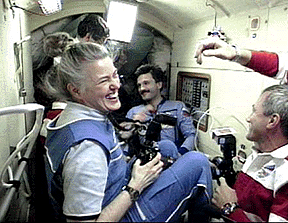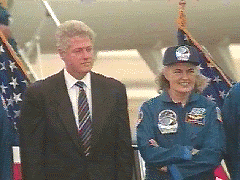The sky is no limit in the space program
The sky is no limit in the space program
By Hillary Rodham ClintonReproduced from the 13 October 1996 Annapolis Capital
| 28 October 1996 |
When I was 14, I dreamed of becoming an astronaut. Inspired by Alan Shephard's pioneering 15-minute trip into space, I wrote NASA to find out what I needed to do to see the stars up close. The space agency thanked me for my interest but said that women were not being considered for the job.
I doubt that I was the only girl to receive a disappointing letter from NASA. And I know that this past spring and summer, I wasn't the only woman who found her old dreams of space travel orbit Earth with Shannon Lucid in a 136-ton space station.
For six months, I was among millions of men and women who cheered each time we heard that Ms. Lucid had broken another space record or when we read reports of her good humor, stamina, and quiet strength during her stay on the Russian space station Mir.

Credit: NASA
We chuckled as she described how she and her two Russian colleagues looked forward to Jell-O for dessert on Sundays. Our admiration grew as she gamely took the news that her return to Earth would be delayed by six weeks. And it was refreshing for all of us to see an American display so much grace and civility in the close quarters of a space station when those attributes sometimes seem to be in short supply on Earth.
I wish I could have been at Kennedy Space Center September 26 to see Ms. Lucid as she defied expectations and walked off the space shuttle Atlantis on her own two feet. (Scientists had thought that after 188 days of weightlessness, she would have been too weak to stand, much less walk.) I wish I could have seen her face when she opened the large box of M & Ms that the president had sent her as a welcome-home present. And I wish I could have been with Bill the next day in Houston when he paid tribute to Ms. Lucid for setting the record for the longest flight by any American -- and any woman -- in space.

Credit: NASA
Like many Americans of my generation, the space program captured my imagination when I was still very young. After the Soviet Union launched Sputnik and became the first country to travel into space, I remember President Eisenhower urging all of us school children to study more math and science. A successful space program, he said, would require many talented and visionary scientists, engineers, and mathematicians. I took his and later President Kennedy's words to heart, feeling that I could play a part in the preparing our country for the future.
My brother and I followed the space program closely. We were glued to our black-and-white television set and pored over the morning papers each time the Mercury astronauts blasted into space. And like many Americans, I remember where I was when Neil Armstrong and Buzz Aldrin landed on the moon. (I was washing dishes at a National Park hotel in Alaska.)
As an adult, I continued to share in every triumph, disappointment, and milestone in our space program -- from Sally Ride's historic shuttle ride to the Challenger explosion, which reminded all of us of the great risk our astronauts take each time they travel into space, to this summer's announcement that there may have been life on Mars.
Perhaps no recent achievement resonates more with American women and girls than Ms. Lucid's. Here's a woman who refused to let prevailing stereotypes limit her interests and ambitions. When she was 13, she wrote an essay about her dream of becoming a rocket scientist. Her teacher laughed at the idea, saying that if there were such a profession, women would never be a part of it. But Ms. Lucid didn't abandon her interest in science -- or space. She learned to pilot an airplane. While raising a family, she got a doctorate in biochemistry.
And, when NASA decided to end its single-sex policy, Ms. Lucid was ready -- and qualified. She joined Sally Ride in the first group of American women astronauts. Today, Ms. Lucid is a veteran of five shuttle missions and one of America's most experienced astronauts.
While there are still many more frontiers of work and space to explore and conquer, Ms. Lucid is living proof to all of us -- and especially our daughters -- that the sky need not be the limit of our dreams and ambitions.

